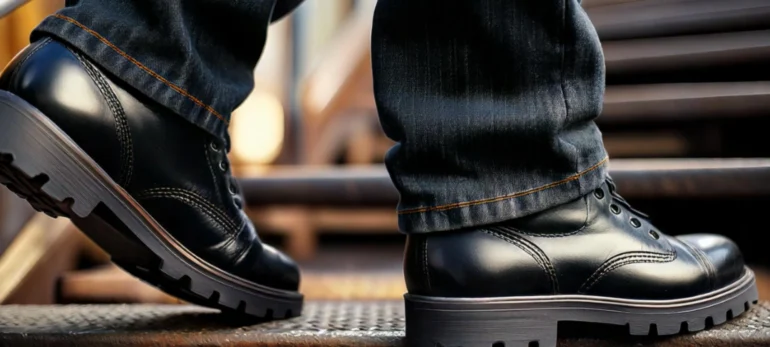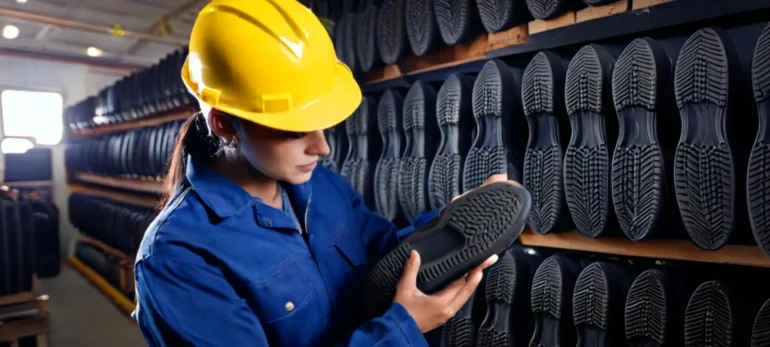Comprehensive Guide to OSHA-Approved Safety Shoes: Protecting Your Feet on the Job
Workplace safety is a critical concern in industries where hazards are part of daily operations. One essential element of protection is industrial safety footwear, specifically OSHA- approved safety shoes. These shoes not only safeguard workers but also ensure compliance with regulations designed to reduce accidents and injuries. This guide delves into the importance of safety shoes for factory workers and highlights how OSHA standards contribute to workplace safety.

1. Introduction to OSHA Standards for Safety Shoes
Overview of OSHA and Its Importance in Workplace Safety
The Occupational Safety and Health Administration (OSHA) establishes guidelines to promote safety and health in the workplace. By enforcing these standards, OSHA ensures that employers provide adequate protection for their workers, particularly in hazardous environments.
Why OSHA Standards for Footwear Matter
Safety shoes act as a frontline defence against injuries caused by falling objects, punctures, electrical hazards, and slips. OSHA-approved safety footwear is specifically designed to meet these challenges, ensuring a safe working environment and reducing downtime due to injuries.
2. Key Requirements for OSHA-Approved Safety Shoes
General Standards and Requirements
OSHA mandates that safety footwear must meet standards such as ASTM F2413, which outlines protective toe requirements, puncture resistance, and electrical hazard protection.

Specific OSHA Regulations for Different Industries
- Construction: Safety shoes must shield against falling objects and punctures.
- Manufacturing: Footwear needs slip-resistant soles and protection against electrical hazards.
- Food Processing: Waterproof and slip-resistant properties are critical.
Key Features That Define OSHA-Approved Footwear
To be OSHA-compliant, safety shoes must provide:
- Protective toe caps (steel, composite, or alloy).
- Electrical hazard protection.
- Slip-resistant outsoles.
- Puncture-resistant midsoles.
3. Types of OSHA-Approved Safety Shoes
Steel Toe Shoes: When and Why they’re Required
Ideal for heavy industries, steel toe shoes offer maximum protection against falling or rolling objects.
Composite Toe Shoes: Benefits and Limitations
Composite toe shoes are lightweight, non-metallic options suitable for environments with metal detectors or where extreme temperatures are a concern.
Alloy Toe Shoes: Lightweight Protection
Combining durability and comfort, alloy toe shoes are 30% lighter than steel but just as protective.
Metatarsal Guard Shoes for Enhanced Safety
These provide additional protection for the upper foot, particularly in industries like mining and manufacturing.
Slip-Resistant and Waterproof Options
For workplaces prone to spills, slip-resistant and waterproof safety shoes prevent accidents and maintain comfort in wet conditions.

4. Selecting the Right Safety Shoes for Your Industry
Construction and Heavy Industry
Look for steel or alloy toe shoes with puncture resistance and metatarsal guards.
Manufacturing and Warehouse Work
Slip-resistant soles, electrical hazard protection, and breathable designs are vital.
Food and Beverage Industry Requirements
Waterproof, slip-resistant, and easy-to-clean footwear is essential.
Healthcare and Laboratory Footwear
Opt for lightweight, chemical-resistant shoes with closed designs to protect against spills.
5. Key Features to Consider in OSHA-Approved Shoes
Slip Resistance and Traction
Essential for reducing slips and falls in wet or oily conditions.
Electrical Hazard Protection
Non-conductive soles protect against electrical shocks, especially in high-voltage areas.
Waterproofing and Breathability
Waterproof materials combined with breathable linings ensure comfort and hygiene in wet environments.
Comfort, Durability, and Fit
Properly fitted shoes reduce fatigue, while durable materials withstand rigorous use.
6. Proper Care and Maintenance of Safety Shoes
Tips for Maximizing Lifespan of Safety Footwear
- Regularly clean shoes to remove dirt and chemicals.
- Check for wear and tear, especially on soles and toe caps.
Cleaning, Storage, and Replacement Guidelines
Store in a cool, dry place and replace shoes once they lose structural integrity or fail to meet safety standards.
7. Common Myths and Misconceptions About OSHA- Approved Shoes
Debunking Misunderstandings Around Safety Footwear
- Myth: Safety shoes are bulky and uncomfortable.
- Truth: Modern designs prioritize comfort with lightweight materials and ergonomic fits.
The Truth About Comfort and Weight of Protective Shoes
Advances in technology have made safety shoes lighter without compromising protection.
Conclusion
OSHA-approved safety shoes protect workers from injuries, reduce downtime, and improve workplace morale. Investing in proper safety shoes for factory workers fosters a culture of safety, ensuring long-term benefits for employees and employers alike. By prioritizing OSHA-compliant safety footwear, industries can enhance worker safety and productivity while staying compliant with essential regulations
Replace safety shoes every 6-12 months or when they show significant wear.
Yes, composite toe shoes meet the same safety standards but offer added benefits like lightweight and temperature insulation.
Absolutely! Many brands offer stylish designs that comply with OSHA standards.

